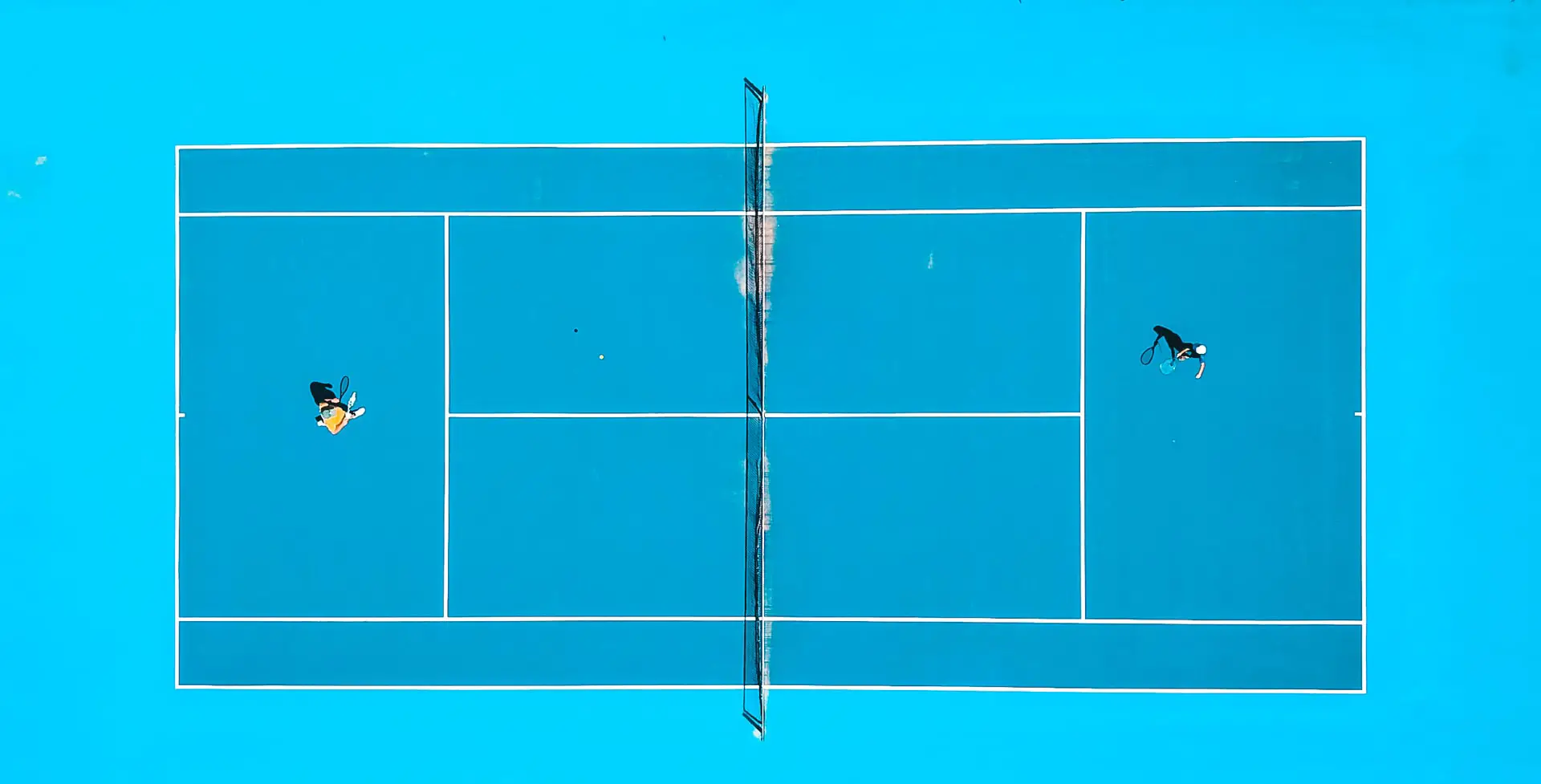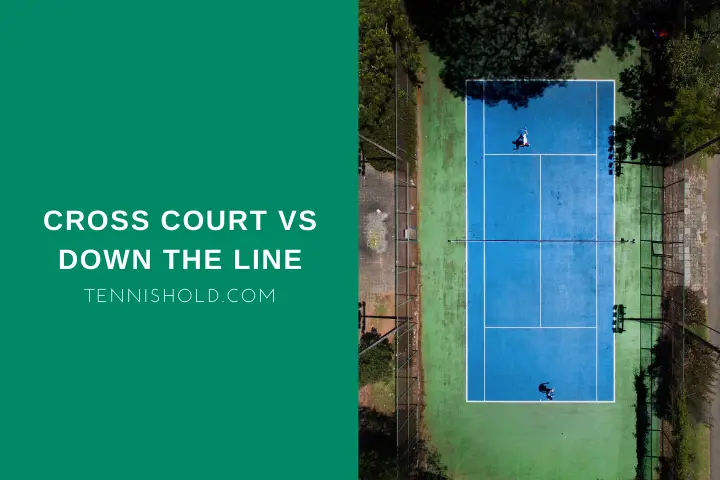If you have seen matches on TV, you will undoubtedly have heard commentators using terms such as cross court and down the line.
As a tennis coach, it seems pretty straightforward, but I often forget there was a time when these terms were confusing for me.
I remember wondering why they would use such complex terms that few would understand. When I found out, it turned out that it was actually pretty simple.
They could have used simpler terms to describe it, though, that is for sure.
What does it actually mean when commentators describe a shot as going “cross-court” or “down the line”?
Cross court refers to a shot that has traveled diagonally from where the player is standing. Down the line refers to a shot that has traveled straight from where the player was standing.
It would be much easier if they referred to it simply as a diagonal or straight shot.
In this article I will discuss:
- What a cross court (diagonal) shot is
- What a down the line (straight) shot it
- The benefits of hitting down the line or cross court
- If hitting down the line is harder.
I can’t promise that reading this article will improve your ability to hit the cross-court or down the line.
What I can promise is that it will give you a comprehensive understanding of the two patterns of play.
What Is A Cross-Court Shot?

A cross-court shot is hit diagonally from one section of the court to the other. The shot can be hit both as a forehand and a backhand.
It can also be hit as a volley. If you volley in a diagonal direction, it would be described as a cross-court volley.
When players hit a cross-court shot on a forehand, they will generally stand in an open or semi-open stance.
Standing in a closed stance will make it harder to hit the cross-court.
Standing in a closed stance makes it tougher to hit cross-court because the feet positioning makes it harder to rotate.
When hitting the cross-court, you want to rotate your body even more than when hitting down the line.
You need to rotate more partly because the distance you need to hit is further.
As you need to send it further, the point when your racket stops contacting the ball is slightly later.
Imagine standing on the baseline of a tennis court, looking at the net.
The section to the right of you, on your side of the net, is known as the deuce side of the court. The part to your left is known as the advantage side.
If you are a right-hander hitting a standard cross-court forehand, you would be standing on the deuce side and hitting the opponent’s deuce side.
The same is true on the backhand, but it would be hitting from the advantage side to the other advantage side.
One type of shot you can hit in tennis is the inside-out forehand. An inside forehand is when you run around your backhand and hit a forehand instead.
To make it an inside-out forehand, you would also have to hit it diagonally. An inside-out forehand is a cross-court shot.
A right-handed inside-out forehand would be hit from the advantage side of the court to the opponent’s advantage side.
Even though this is not a traditional cross court shot, it would be considered one as it is travelling diagonally.
What Is A Down The Line Shot?

A down-the-line shot is hit forward in a more or less straight line from where the player is standing.
If a right-handed player was to hit a down-the-line forehand, they would usually hit from the deuce side to the opponent’s advantage side.
The title can be a little misleading.
I have had to explain to people several times that their shot doesn’t need to literally hit the line to be considered a down-the-line shot.
At the professional level, you will often see people hit down the line shots that just clip the line.
When hitting a down-the-line shot, players will stand in a more closed stance. The reason for this is that they don’t want to over-rotate.
If they over-rotate, the odds of the ball going cross-court are higher.
In tennis, you want to follow the ball’s path you have just hit.
If (as a right-hander) you are rotating too much on the forehand, your weight will go to the left.
This is not where you want it to go if your aim is to hit down the line.
In the previous section, I talked a little bit about inside-out forehands. However, there is another type of inside forehand you can hit, which goes down the line.
This is known as an inside-in forehand.
A right-hander hitting an inside-in forehand would step around their backhand and hit a forehand that goes down the line.
This would normally involve the sending player standing on the advantage side and hitting to the receiver’s deuce side.
Main Strategic Benefits Of Each Shots?

The answer to most tactical questions in tennis is it depends. Sometimes hitting cross-court is a better choice. Other times down the line is the superior option.
In most cases, the benefit of hitting cross-court is more consistency. Most of the time, the ball will be going diagonally.
There are several reasons, but one is there is more room for error.
If you measure the distance from the two diagonal ends of the court, they will be longer than the length between the two baselines.
The baseline-to-baseline distance is 78 feet (23.77 meters). However, if measured from the diagonal corners in singles, it increases by 4.5 feet (1.37 meters).
This means that if hitting from the most extreme angle of the court, you have 4.5 feet more room for error.
The main benefit of hitting down the line is to change direction. You will have created an angle if you have been rallying for a while and managed to push your opponent out wide.
As the opponent is in one corner of the court, you can hit down the line.
It will be harder for them to have a longer distance to run. You are also more likely to hit a winner as they are further away from the ball.
A popular tactic is to pin the opponent in the corner, using cross court shots to build up to the moment when you can attack down the line.
Is Hitting Down The Line More Difficult?

Hitting down the line is widely regarded as tougher than striking cross-court.
The reason for this is that you must also change its direction in addition to sending the ball where you want to.
You will need to not just point your strings at the ball but the contact at the right time and at a different angle.
You don’t often see tennis players constantly moving each other side-to-side. As a result, hitting down the line is a higher risk shot.
It depends on how you play and who you are competing against.
Say you are playing someone who is very consistent and comfortable hitting cross-court. Then, you could argue that down the line is lower risk.
If I am to generalize, hitting down the line is more difficult.
Final Words
To have a well-rounded tennis game, you need to be confident hitting both cross-court and down the line.
Even if you are not feeling positive about your ability to hit down the line, I hope you better understand when to do so.
What do you prefer? Hitting down the line or cross-court?
I love hitting down the line, but I’m guilty of doing it too often. It is a high-risk shot, but it feels so good when you manage to pull it off as a winner.
Sometimes it is hard to resist the temptation.

